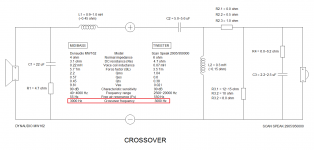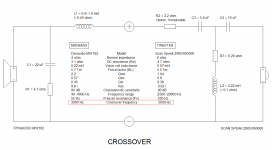Dynaudio basses are pretty straightforward on crossover filter:
Esotec MW 162 Woofer - Dynaudio aftermarket car audio system
All the details are here:
https://dynaudiodata.blob.core.windows.net/media/2510/dyn_automotive_brochure_int_dp.pdf
Closed box driver. 10 or preferably 15L volume.
0.9 or 1mH bass coil and 4.7R plus 22uF impedance correction for about 3kHz crossover.
Bit like this Lynn Olson Ariel:
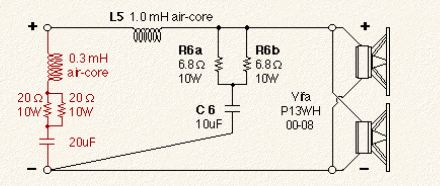
Tweeter filter can resemble this:
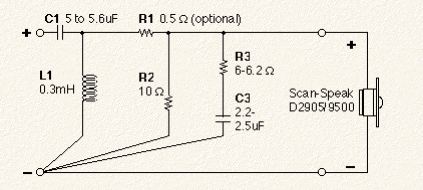
Some level adjustment would be necessary on this second order.
I would go with Troels Gravesen's third order and increase R1011 to taste.
ScanSpeak-9500-9700-9900
This sort of thing is too complicated:
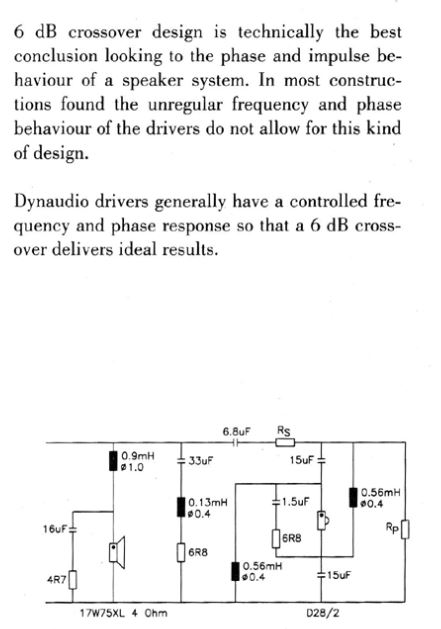
Esotec MW 162 Woofer - Dynaudio aftermarket car audio system
All the details are here:
https://dynaudiodata.blob.core.windows.net/media/2510/dyn_automotive_brochure_int_dp.pdf
Closed box driver. 10 or preferably 15L volume.
0.9 or 1mH bass coil and 4.7R plus 22uF impedance correction for about 3kHz crossover.
Bit like this Lynn Olson Ariel:
Tweeter filter can resemble this:
Some level adjustment would be necessary on this second order.
I would go with Troels Gravesen's third order and increase R1011 to taste.
ScanSpeak-9500-9700-9900
This sort of thing is too complicated:
Hi System7
Thank you very much, I will learn and try one by one according to your instructions, then I will choose the one I like best. I'll let you know once it's done. Hope you don't wait too long 🙂
Thank you very much, I will learn and try one by one according to your instructions, then I will choose the one I like best. I'll let you know once it's done. Hope you don't wait too long 🙂
I look forward to hearing how it turns out. I don't think you need any more than your ears as measuring equipment here. 😀
This is the theory with fitting filters together:
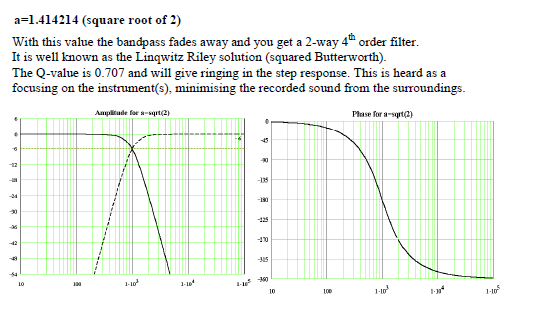
Just had a nagging thought the tweeter may need negative polarity with a steepish rolloff Dynaudio driver. I use crimp tags to connect drivers to the wiring.
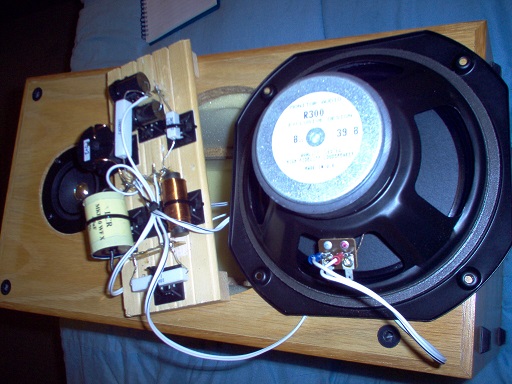
Last time I modelled a 6dB crossover, like the Dynaudio circuit above, into a third order, polarity swapped on the tweeter for phase alignment. Just a question of swapping tags on the tweeter if it sounds phasey or echoey at the 3Khz crossover. Choose the one you think sounds best!
This is the theory with fitting filters together:
Just had a nagging thought the tweeter may need negative polarity with a steepish rolloff Dynaudio driver. I use crimp tags to connect drivers to the wiring.
Last time I modelled a 6dB crossover, like the Dynaudio circuit above, into a third order, polarity swapped on the tweeter for phase alignment. Just a question of swapping tags on the tweeter if it sounds phasey or echoey at the 3Khz crossover. Choose the one you think sounds best!
Regarding the SS 9300 vs 9500 tweeter, I've done my own evaluation between them and feel the 9300 sounds more natural and relaxed. I use the 9300 in a 3 way with D52AF Dynaudio mid dome and M26WR09-08 Vifa woofer, crossed at 4k and 700 LR2 in a variovented enclosure. No padding needed on either mid or tweeter. Its been my go to 3 way speaker for classical, acoustic and vocal playback.
The 9300 is one of my all time favorite one inch soft domes apart from the morel CAT378 (which is the horn loaded version of CAT308). It doesn't over hype the top end in any way and just exposes every non musical flaw. The Seas 27TFFC is great too, but doesn't do dynamics as well. Most modern 28mm or smaller soft domes tend to have some kind of smoothed and veiled breakup above 10k, but the SS 9300 doesn't do this. If you want cleaner top end you have to use a hard dome, but those tend to be unforgiving and difficult to marry with CD quality digital sources.
The 9300 is one of my all time favorite one inch soft domes apart from the morel CAT378 (which is the horn loaded version of CAT308). It doesn't over hype the top end in any way and just exposes every non musical flaw. The Seas 27TFFC is great too, but doesn't do dynamics as well. Most modern 28mm or smaller soft domes tend to have some kind of smoothed and veiled breakup above 10k, but the SS 9300 doesn't do this. If you want cleaner top end you have to use a hard dome, but those tend to be unforgiving and difficult to marry with CD quality digital sources.
Hi System7
Thank you, i will try as you advise.I look forward to hearing how it turns out. I don't think you need any more than your ears as measuring equipment here. 😀
This is the theory with fitting filters together:
Just had a nagging thought the tweeter may need negative polarity with a steepish rolloff Dynaudio driver. I use crimp tags to connect drivers to the wiring.
Last time I modelled a 6dB crossover, like the Dynaudio circuit above, into a third order, polarity swapped on the tweeter for phase alignment. Just a question of swapping tags on the tweeter if it sounds phasey or echoey at the 3Khz crossover. Choose the one you think sounds best!
Hi friends,
I have built these 2 FCs following System7's instructions.
But I don't know clearly if the cutoff point at 3000Hz has been calculated correctly for both cases
Anyone know please help me
I will start doing it soon
I have built these 2 FCs following System7's instructions.
But I don't know clearly if the cutoff point at 3000Hz has been calculated correctly for both cases
Anyone know please help me
I will start doing it soon
Attachments
Possibly because they are cheaper! 🙂
Yes, i guess you are right
The tweeter circuits are from existing designs, so i believe it is safe to assume the tweeter will be fine in terms of not being overstressed.
You have used the recommended impedance equalisation networks in the links.
it needs tuning by listening and adjusting the bass coil inductance, the recommended values may work well or you may need to slightly increase or decrease the coil value beyond the values given and then when happy with the sound try a reversal of the tweeter circuit phase to see if that makes it sound worse or better.
Without modelling or measuring the frequency response it is difficult to verify if they are aligned for a 3Khz crossover.
The second circuit you have posted looks the easiest to tune by changing values of L1 and R2 until you have a good sound.
Measuring or modelling the loudspeaker in your enclosure would give you more information, but this will get you up and running.
You have used the recommended impedance equalisation networks in the links.
it needs tuning by listening and adjusting the bass coil inductance, the recommended values may work well or you may need to slightly increase or decrease the coil value beyond the values given and then when happy with the sound try a reversal of the tweeter circuit phase to see if that makes it sound worse or better.
Without modelling or measuring the frequency response it is difficult to verify if they are aligned for a 3Khz crossover.
The second circuit you have posted looks the easiest to tune by changing values of L1 and R2 until you have a good sound.
Measuring or modelling the loudspeaker in your enclosure would give you more information, but this will get you up and running.
That tweeter can easily cope with a 3k filter @ 12dB and even at 6dB, but power handling obviously becomes an issue with a first order slope. Above 3k at 12dB its good for a 100 W continous system power rating with a decent woofer. Dunlavey used this tweeter in some of their larger setups and ran them with a first order filter and LCR notch, so the tweeter can acoustically cope for sure, even at decent output levels.
Hi Raymondj
I also think I should follow the second circuit and try to change the values until it sounds good to my ears.
Thank you for your support,The tweeter circuits are from existing designs, so i believe it is safe to assume the tweeter will be fine in terms of not being overstressed.
You have used the recommended impedance equalisation networks in the links.
it needs tuning by listening and adjusting the bass coil inductance, the recommended values may work well or you may need to slightly increase or decrease the coil value beyond the values given and then when happy with the sound try a reversal of the tweeter circuit phase to see if that makes it sound worse or better.
Without modelling or measuring the frequency response it is difficult to verify if they are aligned for a 3Khz crossover.
The second circuit you have posted looks the easiest to tune by changing values of L1 and R2 until you have a good sound.
Measuring or modelling the loudspeaker in your enclosure would give you more information, but this will get you up and running.
I also think I should follow the second circuit and try to change the values until it sounds good to my ears.
This is a "Get you up and running" sort of circuit. Bit of guesswork involved!
I do suspect it will be positive polarity on the tweeter, but without modelling, who knows... 😀
I dug up a thread about Dynaudio drivers:
Crossover help needed for Dynaudio 17W75XL(ohm) and D260
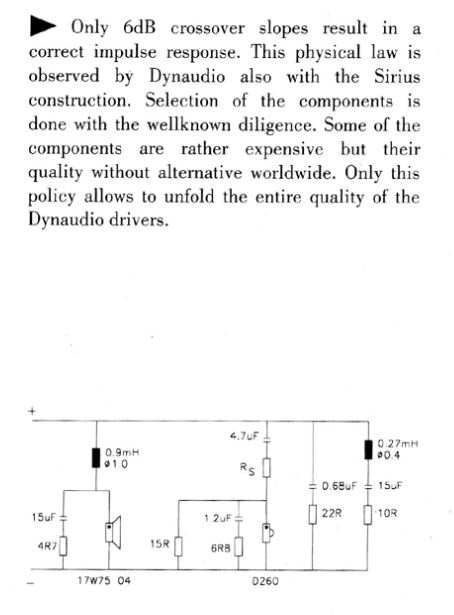
Admittedly using the 8 ohm woofer in that thread. Some of the 4 ohm designs with impedance correction, ie the 4.7uR and 22uF seem to cross at 2.2 kHz on the -6dB point of the woofer with around 1mH coil. It would be simple enough to reduce the coil to (say) 0.68mH for nearer 3kHz. But it is such a shallow rolloff I wonder how much difference you will hear?
My approach is to get something that vaguely works and fine tune it to my ears. In this case it's only the bass coil and the tweeter resistor that do much to the sound.
I do suspect it will be positive polarity on the tweeter, but without modelling, who knows... 😀
I dug up a thread about Dynaudio drivers:
Crossover help needed for Dynaudio 17W75XL(ohm) and D260
Admittedly using the 8 ohm woofer in that thread. Some of the 4 ohm designs with impedance correction, ie the 4.7uR and 22uF seem to cross at 2.2 kHz on the -6dB point of the woofer with around 1mH coil. It would be simple enough to reduce the coil to (say) 0.68mH for nearer 3kHz. But it is such a shallow rolloff I wonder how much difference you will hear?
My approach is to get something that vaguely works and fine tune it to my ears. In this case it's only the bass coil and the tweeter resistor that do much to the sound.
HelloRegarding the SS 9300 vs 9500 tweeter, I've done my own evaluation between them and feel the 9300 sounds more natural and relaxed. I use the 9300 in a 3 way with D52AF Dynaudio mid dome and M26WR09-08 Vifa woofer, crossed at 4k and 700 LR2 in a variovented enclosure. No padding needed on either mid or tweeter. Its been my go to 3 way speaker for classical, acoustic and vocal playback.
The 9300 is one of my all time favorite one inch soft domes apart from the morel CAT378 (which is the horn loaded version of CAT308). It doesn't over hype the top end in any way and just exposes every non musical flaw. The Seas 27TFFC is great too, but doesn't do dynamics as well. Most modern 28mm or smaller soft domes tend to have some kind of smoothed and veiled breakup above 10k, but the SS 9300 doesn't do this. If you want cleaner top end you have to use a hard dome, but those tend to be unforgiving and difficult to marry with CD quality digital sources.
Could you describe what is exactly the difference (big difference, small difference or where is the difference, tonality, etc.) in sound between the 9300 and 9500 version? I have now the 9300 and I like it but always wanted to know why people choose the 9500 over the 9300. I had Seas 27TDFC and 27TFFC before but I prefer the more natural sounding Scanspeak. The 9300 is very linear, calm and not over emphasize anything and you can listen no matter how many hours if the source is vinyl, CD, it doesn't mean. I really like it. I think the 9300 and 9500 can be very similar, but of course it should have some sonic difference. I use the 9300 @ 3K/12db, more than enough.
Other candidate was also the Scanspeak D2608/91300 the "HDS" but I never heard it or who compared with the 9300/9500. Thanks.
- Home
- Loudspeakers
- Multi-Way
- Scanspeak d2905 9300 vs 9500
